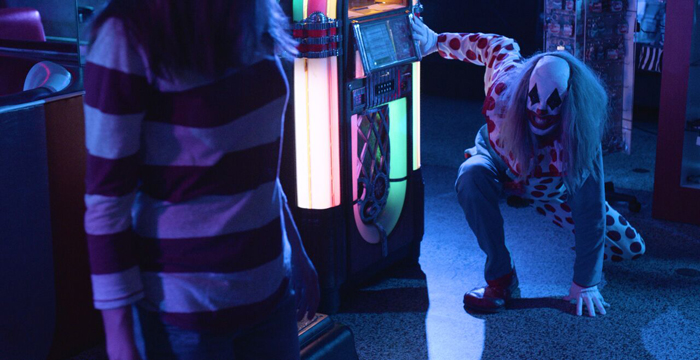This messy world, these complicated times, there are a million things I could and should be considering, but right now, my brain is devouring itself considering clowns, and the metrics we can possibility utilize, as a society, to measure peak clown saturation. When did clowns become frightening? And are clowns frightening, or have we created a culture of fear around them that has carried so thoroughly through that now more people associate them with terror than with any sense of comedy? In short – ok, perhaps a bit too late for that – I’ve got questions. And true, none of them were answered by Clowntergeist. But in its defense, it did not promise me any resolutions; it does, however, succeed in being a great deal more entertaining than a movie called Clowntergeist has any right to be.
So great, Kell, you’ve waxed semi-rhapsodic about the place of clowns in our current society, but what’s the movie actually about? Good question, fair question, I’m glad you asked. Our major focus is on Heath and Emma, two young women living in a college town during the summer. They live together, they scoop ice cream together, they fear the local madman together. Oh, by the way, there’s a local madman., which in this case translates to “evil murder clown.” This is established by the extremely improbable circumstance of the sheriff coming into the ice cream parlor/hardware store (you know the type) and announcing that there is a manhunt going on, and that everyone who can leave town, should leave town. I will grant you that I am not in law enforcement and have overseen precious few manhunts, but telling everyone to flee town seems sort of counter-intuitive to me. But let’s table that.

In a movie called Clowntergeist, you can pretty safely assume that at least one character is going to suffer from coulrophobia, and in this case, it’s Emma, who could pretty readily have “Final Girl” tattooed across her forehead. She establishes early on that she has a history with night terrors, but pretty swiftly grants her nightmares the concrete status of reality. She sees a bloody sink with her dog’s tags in it and a balloon with a date. A ticking clock element may be the cleverest component of Clowntergeist – it adds a component of slightly un-earned suspense and anticipation. Emma kibbutzes with the father of another girl who was terrorized and ultimately murdered by a clown we will come to learn is named Ribcage (more on that stunning bit of nomenclature later,) and determines pretty definitively that she’s next. Ribcage speaks to Emma through her car radio and establishes that he’s targeting her because of her pre-existing fear. We accept this logic because, despite the fact that presumably literally everyone would be frightened of a randomly materializing clown with a big evil face and bloody balloons, this is a movie called Clowntergeist and really, who are we fooling? We’re just waiting to see Ribcage do evil shit. And wait we do.
The movie disseminates Ribcage with a conservative hand, building suspense where and when it can. There is a certain wisdom to this; I appreciate an effort to flesh out story and build character affection. And in a lot of ways, it works. Heather and Emma are charming; their friendship feels real and lived in. Ultimately, I did not want them to get eaten by a killer clown who bears more than a passing resemblance to Pennywise (down to an inexplicable affection for red balloons.)
But is it good? No, of course it’s not good. It’s called Clowntergeist. But not being good does not immediately equate to being bad, especially in horror, a genre that basically defies easy formal criticism. The question of “is it good” is extremely secondary to “is it effective.” And in certain respects, the answer is a resounding yes. Are you engaged, despite yourself? Absolutely. Do you develop a weird affection for the characters? Totally. Do you want to find out what happens? Sure. Is it scary? That’s a horse of a different color. The degree of fear Clowntergeist will inspire in you is directly correlated to the degree of fear you already experience at the prospect of clowns. For me, personally, it was minimal. I don’t find clowns particularly scary, and as mentioned in paragraph one (feel free to revisit, the water’s fine,) we have perhaps reached peak clown ubiquity. We are in a moment where Pennywise has a two plus hour movie in theaters and American Horror Story has some sort of clown storyline, I don’t know what it is, but you’ve seen the ads, you know what I’m talking about. What measures could be taken to return to the clown a sense of the alien, the strange, the intimidating, I’m not certain of. They’ve become more iconic than specific, and in doing so, lost a measure of their power to scare those who are not already infected with coulrophobia. But this can’t be blamed on Clowntergeist. And if you have an hour and twenty minutes to kill, there are a lot worse ways to murder it.
